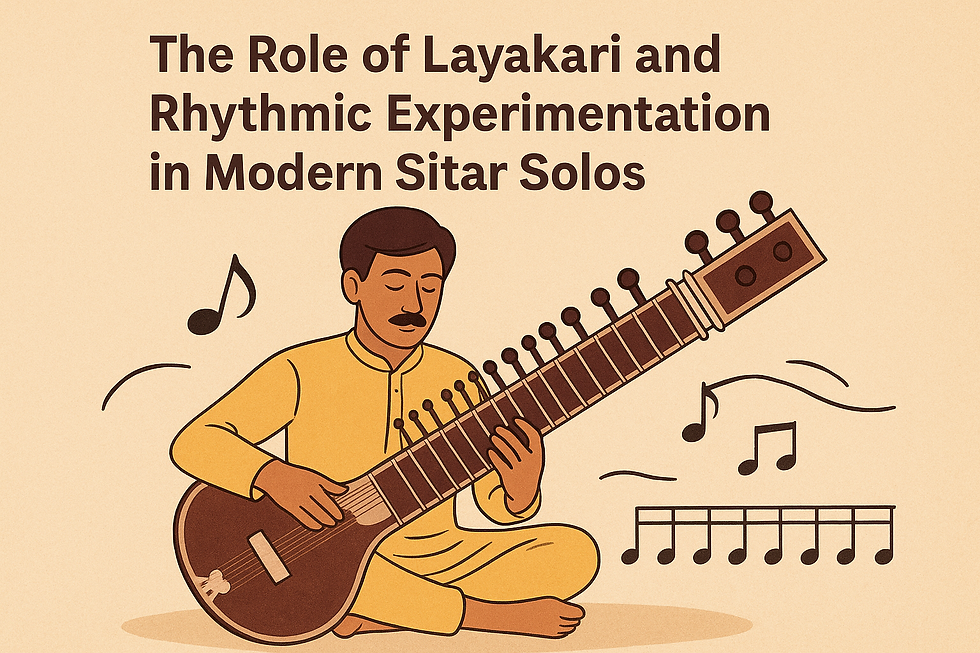"Advanced Ornamentations: Soot, Krintan, and Murki on Sitar"
- Sharanya naidu
- Nov 17
- 3 min read
Hello, dedicated music learners! If you've mastered the basics—the Meend (glide) and the fundamental Taals and Gats—you’re ready to dive into the beautiful, intricate world of advanced Sitar ornamentations.
These subtle, yet powerful, techniques are the vocal soul of instrumental music. They are what elevate a note sequence into a heartfelt melody, giving the Sitar its distinct, expressive voice.

Today, we focus on three essential aesthetic forms: Soot, Krintan, and Murki.
1. ⚡ Soot (The Seamless Slide)
Soot is often used interchangeably or alongside Ghasit (a rapid slide). It's a key technique for achieving a fluid, vocal quality in your playing.
What is Soot?
Definition: Soot is a rapid, smooth slide between two or more notes played without a second stroke of the Mizrab (plectrum).
The Technique: You strike the first note with your Mizrab, and then, using the same finger, you slide (or pull) along the fret wire or the fingerboard to the next note, maintaining pressure and continuity of sound.
Aesthetic Effect: It connects notes in a perfectly unbroken sweep, creating a sense of flow and continuity. If the Meend is a slow, graceful arc, the Soot is a quick, decisive brushstroke.
💡 Practice Tip: Start with a small, close interval (e.g., Sa to Re) on the main string. Focus on the speed and smooth transition of your left-hand finger to avoid any break in the sound after the initial strike.
2. 🪶 Krintan (The Plucking Grace Note)
Krintan adds a delicate, crisp texture to descending phrases. It's an essential technique that makes the Sitar sound sparkling and agile.
What is Krintan?
Definition: Krintan is a technique used primarily in a descending order where the second note is sounded by a left-hand pull/flick on the string, without a Mizrab stroke.
The Technique:
Strike the first, higher note (Re) with the Mizrab.
Immediately, your left-hand finger plucks the string downward or sideways as it lifts from the fret, producing the sound of the lower note (Sa) which is already being fretted by another finger (or by itself if returning to an open string).
Aesthetic Effect: It produces a distinct, slightly quieter, and very rapid grace note. It is the opposite of the Aas (a quick hammer-on ascending technique) and gives a beautiful, feather-light closure to a phrase.
💡 Practice Tip: Place two fingers on adjacent frets (e.g., middle finger on Re, index finger on Sa). Strike Re, then quickly "flick" the string with the middle finger as you lift it. This must be a clean, distinct pluck that highlights the Sa note.
3. ✨ Murki (The Intricate Ornament)
Murki literally means a 'twirl' or 'coquettish turn' and is a compact, vibrant cluster of notes that adds immense charm and complexity.
What is Murki?
Definition: Murki is a short, rapid, three-note phrase (often a main note, a neighboring note, and a return to the main note, like Sa-Re-Sa or Sa-Ni-Sa), played with a single Mizrab stroke.
The Technique: A Murki is typically a combination of other techniques like Aas (hammer-on) and Krintan (pull-off), all played so fast they sound like one continuous flourish.
Strike the first note (Sa) with the Mizrab.
The movement from Sa to Re is often a swift Aas (hammer-on).
The movement from Re back to Sa is an equally swift Krintan (pull-off).
Aesthetic Effect: It is a glittering, quick flourish used to decorate or emphasize a note, adding emotional depth and a playful, dancing quality to the melody. It’s one of the most recognizable and expressive ornaments in Hindustani music.
💡 Practice Tip: Break down the Murki into its components (Aas + Krintan). Practice the two-note movements first until they are seamless. Only then combine them and try to execute the entire three-note pattern with the speed and lightness of a single stroke.
Why Practice These Advanced Forms?
In Hindustani Classical Music, the emphasis is on Raga Rasa—the emotional flavor of the Raga. These advanced ornamentations are the tools that allow the Sitar player to truly express this Rasa.
Soot gives phrases continuity and melancholy.
Krintan adds sparkle and rhythmic precision.
Murki injects charm, complexity, and vocal grace.
Mastering these will move your playing from technically correct to emotionally evocative. It's a long journey, but every single Soot, Krintan, and Murki you perfect brings you closer to being a truly expressive Sitarist!



Comments